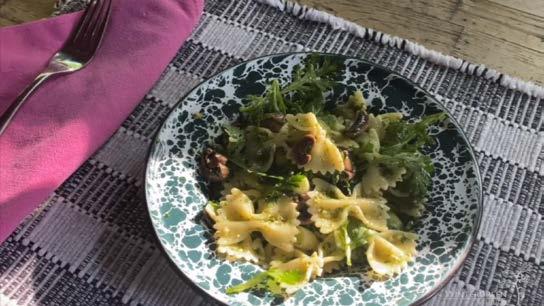
5 minute read
Edible Wild Delicacies and Delights
By Monica Capovilla, Executive Director, Wintergreen Studios, Limestone Chapter
As the world sheltered in place in the spring of 2020, we began to devote more time to our gardens, both cultivated and wild. We planned more native plantings for our bees and paid more attention to the forageable wild food that was right under our noses. One of the few good things to come out of a global pandemic is that it invited us to slow down, take a breath, and explore that which grows around us—and take it into our kitchen to create delicious gourmet meals. The 100-mile diet? More like 100 feet! There was a time when we would see dandelions peeking between the stones on the Lodge porch at Wintergreen Studios and think, “weeds!” but now we think, “lunch!”. Common Dandelion (Taraxacum officinale), also known as blowball, wet-a-bed, Irish daisy, or wild endive, is a flowering perennial plant that likely evolved over 30 million years ago. They are native to Eurasia and widespread throughout temperate North America, growing in fields and places with disturbed soil. Their seeds are wind dispersed and they germinate easily, making them a prolific food source!
Advertisement
Not only are dandelions an incredibly vital early spring nectar source for pollinators, including the honey bees found in the 9th Meadow Apiary at Wintergreen, but they are also packed full of nutrients—they can just be as nutritious as more commonly known leafy greens like spinach and kale. Dandelion greens contain high amounts of vitamins A, C, and K, and moderate sources of calcium, potassium, iron, and manganese. All of that, free for the foraging, in our backyards! Though they are commonly considered an invasive species and can be annoyingly pervasive (if we had a nickel for every time we have seen people weeding dandelions from their front lawns, we would be rich!), the entire plant is edible. The leaves, the flowers, the stems, the roots. The leaves (young leaves are preferable to avoid bitterness) and stems are delicious sautéed or added to soups, the roots can be roasted and ground as a coffee substitute (in flavour), the flowers can be eaten raw (rinsed well) and tossed into salads for a pop of colour and surprising sweetness, or the petals can be used to make wine or infused vinegar, among other things. Our favourite? Both the leaves and flowers added alongside cheddar cheese, heavy cream, eggs, and cherry tomatoes in a Latvian-inspired Dandelion Flower Omelette. Top it off with a little bit of Garlic Mustard Pesto and you have got your yourself an incredibly tasty and hearty breakfast.
Dandelion flower omelette
“Wait… garlic mustard pesto? That is, uh, unusual.” Perhaps. But is it delicious and easily sourced? You bet! The idea of consuming garlic mustard, known to be aggressively invasive, may sound strange but trust us—once you learn more about its nutritional benefits (and tasted its fresh, garlicky notes), you will be wishing it was spring. Garlic Mustard (Alliaria petiolata), also known as hedge garlic, Jack by the hedge, or poor man’s garlic, is an extremely hardy biennial flowering plant native to Europe and parts of Asia and Africa. It was brought to North America in the early 1800s by European settlers who used it for food and medicine. The entire plant is edible (its leaves are often used as a flavouring in salads, soups, dips, sauces, and fish) and is one of the oldest spices used in Europe, dating back to 4100 BCE in Germany and Denmark. It contains substantial amounts of vitamins A, C, E, and some B vitamins as well as potassium, calcium, magnesium, selenium, copper, iron, manganese, and omega-3 fatty acids. As with many non-native species, garlic mustard is invasive and is now one of Ontario’s most aggressive forest invaders as its seeds spread easily and can grow almost anywhere—in stable forests or in newly disturbed soil, in deep shade or full sunlight. All by way of saying, it is very abundant and can be harvested at will. Every summer we admire the beautiful, lush patch of garlic mustard that tumbles
its way down the glade beyond the Hobbit House, knowing it will soon become a delicious pesto. We would not usually use the words ‘beautiful’ and ‘lush’ in the same sentence as garlic mustard, given its invasive nature, but when we are talking about harvesting it for food, the more the better!

Garlic mustard growing beside Hobbit House at Wintergreen Studios
We recommend seeking out second-year garlic mustard plants before they flower for the freshest flavour and best results. Second-year plants (in early to mid-spring) can be anywhere from one foot to almost three feet tall with alternating broad, kidney-shaped leaves on the lower half (up to 10 centimetres across) and more triangular leaves (five to 10 centimeters across), narrowing toward the tip. Simply pluck the leaves (the younger the better), rinse well, and toss into a food processor with olive oil, garlic, nuts (we like the earthiness of walnuts), parmesan cheese, salt, and pepper. Blitz until well blended but still chunky and voilà—pesto from your

Garlic mustard leaves and flowers in colander own backyard (or other nearby green space)! Serve over pasta or steamed fish, slather on flatbreads, or add to tomato soup for a pop of flavour.

Pasta with garlic mustard pesto
Disclaimer: if you are harvesting garlic mustard, learn how to properly do so as to reduce its impact and prevent it from spreading to other native areas. As it is an aggressively invasive species, one plant can generate thousands of seeds, which remain viable up to 12 years, and stands of garlic mustard can double in size every four years. It is best to pull up the plant by its roots otherwise it can displace many native wildflower species, such as trilliums and trout lilies, by interfering with the growth of fungi that bring nutrients to their roots. While tempting to throw them into the compost bin or nearby areas, we recommend instead disposing of the plant in the garbage as discarded flowers may still produce seeds.
We encourage you to take the time to adjust your relationship with what are referred to as ‘weeds’ (or as we like to say, ‘free food!’), explore the green spaces around you, and harvest safely. Rule of thumb: when in doubt, do not put it in your mouth. There are many reputable field guides, apps such as iNaturalist, and communities of experts that can help you identify wild plant species. So head outside, keep it local, and know before you eat. Some of the wild edible recipes mentioned in this article appear in our new cookbook, Cooking at Wintergreen, and others can be downloaded by visiting wintergreenstudios.com/wild-edibles. ❧










